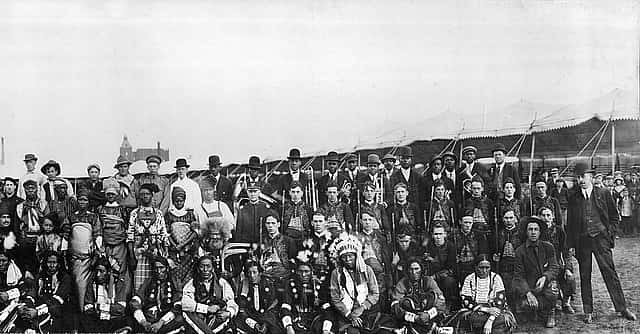
Black Musicians in the Wild West
Originally published in Points West magazine History Edition, Winter 2024
Black Musicians in the Wild West: The Curious History of Ferris’s Satisfied Musical Entertainers
By Siriana Lundgren
Beyond its regular and lively cast of characters, the 1910 season of the combined Buffalo Bill’s Wild West and Pawnee Bill’s Far East featured a small sideshow. The eccentric cast included the snake charmer known as Princess Olga, Kathleen the “bag puncher,” and a performer who simply went by “Zip.” In addition to performances by J. McNaughton’s Scotch Band of four bagpipers, the sideshow also hired a promising and talented new musical group that year.
Ferris’s Satisfied Musical Entertainers was a 14-piece ragtime orchestra boasting saxophones, cornets, clarinets, trombones, tuba, and drums. Within the group was also a ragtime vocal quartet, The Ramblers, composed of Melvin Oglesby, Ed Love, Fred Smart, and Ed Tandy.
Lynn Abbot and Doug Serrof, authors of Ragged but Right: Traveling Shows, ‘Coon Songs,’ and the Dark Pathway to Blues and Jazz, point out that sideshow bands almost always had all-Black membership, as the grandstand bands that toured with Wild West shows did not allow Black and white players to integrate.
Ferris’s Satisfied Musical Entertainers were no exception—all members of the band were Black. Buffalo Bill’s Cowboy Band was an all-white ensemble during the 1910 season. Their repertoire was equally segregated.

While the Cowboy Band was playing everything from Handel to The Star Spangled Banner, Ferris’s Satisfied Musical Entertainers performed traditionally Black American genres like ragtime and early forms of the blues. The troupe also engaged in blackface minstrelsy performances, where African American members of the ragtime orchestra deliberately darkened their skin and portrayed caricatures for predominantly Euro-American and European audiences.
Even though Wild West shows tended to feature racially diverse performances on the main arena floor, the existing idea that musical bands should be racially homogenous was reinforced in Wild West shows. Music remained segregated, even if the show itself was not.
But the 1911 program of Buffalo Bill’s Wild West and Pawnee Bill’s Far East mentioned Ferris’s Musical Entertainers not only as a sideshow band, but also as a concert band. The ragtime orchestra and the show challenged the norms of the day by providing a 45-minute concert from Ferris’s Entertainers as attendees exited the grandstand.
A 1911 review of Buffalo Bill’s Wild West from the Black newspaper the Indianapolis Freeman speaks to the uniqueness of the concert band designation: “Unlike any other big show carrying a colored contingency, this show presents Professor Ferris’ company of singers and dancers as the sole and only offering of the concert and after-show in the big top at the conclusion of each performance.” This review stands out as one of the few accounts of a Black sideshow bands’ performance under the big top of any Wild West show.

Ferris’s Satisfied Musical Entertainers, who were paid a tiny fraction of what white musicians with Buffalo Bill’s Wild West and Pawnee Bill’s Far East were paid, stayed with the show for only two seasons. Yet the group would have a lasting impression on the show’s musical landscape.
In 1910, William Sweeney, conductor and creator of Buffalo Bill’s Cowboy Band, was beginning his own foray into ragtime-based composition with his work The Two Bills’ March. It’s hard to know Sweeney’s compositional process for his ragtime influenced works. But there’s no doubt that the presence of a professional Black ragtime orchestra introduced audiences and performers of the Wild West to African-American musical culture in a new (and “satisfied”) way.

About the author
Siriana Lundgren is a PhD Candidate at Harvard University where she researches the women and music of the American West. She worked as a summer intern at the Center of the West in 2023, where she explored the history of Ferris’s Satisfied Musical Entertainers and other musical acts.
Post 353
Written By
Nancy McClure
Nancy now does Grants & Foundations Relations for the Center of the West's Development Department, but was formerly the Content Producer for the Center's Public Relations Department, where her work included writing and updating website content, publicizing events, copy editing, working with images, and producing the e-newsletter Western Wire. Her current job is seeking and applying for funding from government grants and private foundations. In her spare time, Nancy enjoys photography, reading, flower gardening, and playing the flute.
